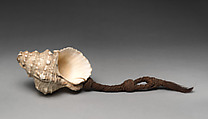Conch Shell Trumpet (Davui)
Not on view
As in many parts of the Pacific, conch shell trumpets in Fiji, called davui, produce a loud sound that carries over long distances and were used as signaling devices rather than played as part of musical ensembles. This example is from the western portion of the island of Viti Levu, whose inhabitants formerly created a distinctive variety of davui. A unique feature of Western Viti Levu shell trumpets is the presence of a small finger hole, bored near the mouth of the shell, which allowed the player to vary the pitch when playing, creating a rising and falling tone. Virtually all other Pacific trumpets emit only a single note. In contrast to other Fijian conch shell trumpets, western Viti Levu davui were end-blown, with a blowing hole made by removing the apex of the shell, rather than side blown (using a hole made in the side of the instrument). They were also frequently decorated, as here, with elaborate rope-like tassels made from coconut husk fiber while those in other parts of Fiji were unornamented.
Due to rights restrictions, this image cannot be enlarged, viewed at full screen, or downloaded.
This artwork is meant to be viewed from right to left. Scroll left to view more.



